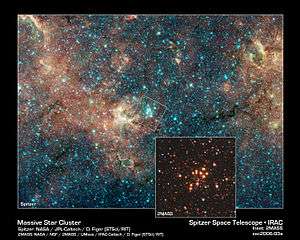RSGC1
| RSGC1 | |
|---|---|
|
Spitzer image of RSGC1 | |
| Observation data (J2000 epoch) | |
| Constellation | Scutum |
| Right ascension | 18h 36m 29s[1] |
| Declination | −06° 52′ 48″[1] |
| Distance | 22.0 ± 2.9kly (6.60 ± 0.89kpc[2]) |
| Apparent magnitude (V) | not visible[2] |
| Apparent dimensions (V) | ~1.5′[3][1] |
| Physical characteristics | |
| Mass | ~3 × 104[2] M☉ |
| Radius | 1.5 ± 0.3 pc[2] |
| Estimated age | 10–14 my[2][1] |
RSGC1 (Red Supergiant Cluster 1) is a young massive open cluster belonging to the Milky Way galaxy. It was discovered in 2006 in the data generated by several infrared surveys, named for the unprecedented number of red supergiant members.[3] The cluster is located in the constellation Scutum at the distance of about 6.6 kpc from the Sun. It is likely situated at the intersection of the northern end of the Long Bar of the Milky Way and the inner portion of the Scutum–Centaurus Arm—one of its two major spiral arms.[4]
The age of RSGC1 is estimated at 10–14 million years. The cluster is heavily obscured and has not been detected in the visible light. It lies close to other groupings of red supergiants known as Stephenson 2, RSGC3 and Alicante 8. The mass of RSGC1 is estimated at 30 thousand solar masses, which makes it one of the most massive open clusters in the Galaxy.[2]
The observed red supergiants with the mass of about 16–20 solar masses are type II supernova progenitors.[2] Over 200 main sequence stars have been detected with masses over 8 M☉, which allows the distance to be determined from main sequence fitting. Fourteen red supergiant members have been identified.[1]
| Star | Spectral type | Magnitude (K band) | Temperature (effective, K) | Absolute magnitude | Luminosity (L☉) |
|---|---|---|---|---|---|
| F01 | M5 | 4.962 | 3,450 | −11.75 | 263,000 |
| F02 | M2 | 5.029 | 3,660 | −11.92 | 363,000 |
| F03 | M5 | 5.333 | 3,450 | −11.28 | 174,000 |
| F04 | M1 | 5.342 | 3,752 | −11.24 | 209,000 |
| F05 | M4 | 5.535 | 3,535 | −11.36 | 195,000 |
| F06 | M5 | 5.613 | 3,450 | −10.70 | 100,000 |
| F07 | M3 | 5.631 | 3,605 | −10.81 | 126,000 |
| F08 | M3 | 5.654 | 3,605 | −11.33 | 200,000 |
| F09 | M6 | 5.670 | 3,399 | −10.92 | 117,000 |
| F10 | M3 | 5.709 | 3,605 | −10.86 | 132,000 |
| F11 | M5 | 5.722 | 3,535 | −11.03 | 145,000 |
| F12[3] | M0 | 5.864 | −10.70 | 200,000 | |
| F13 | K2 | 5.957 | 4,015 | −11.39 | 282,000 |
| F14 | M3 | 6.167 | 3,605 | −10.25 | 74,000 |
| F15 | G0 | 6.682 | 6,850 | −10.07 | 229,000 |
References
- 1 2 3 4 5 Froebrich, D.; Scholz, A. (2013). "The main sequence of three red supergiant clusters". Monthly Notices of the Royal Astronomical Society. 436 (2): 1116–1122. arXiv:1308.6436
 . Bibcode:2013MNRAS.436.1116F. doi:10.1093/mnras/stt1633. ISSN 0035-8711.
. Bibcode:2013MNRAS.436.1116F. doi:10.1093/mnras/stt1633. ISSN 0035-8711. - 1 2 3 4 5 6 7 8 Davies, B.; Figer, D. F.; Law, C. J.; Kudritzki, R. P.; Najarro, F.; Herrero, A.; MacKenty, J. W. (2008). "The Cool Supergiant Population of the Massive Young Star Cluster RSGC1". The Astrophysical Journal. 676 (2): 1016–1028. arXiv:0711.4757
 . Bibcode:2008ApJ...676.1016D. doi:10.1086/527350.
. Bibcode:2008ApJ...676.1016D. doi:10.1086/527350. - 1 2 3 Figer, D. F.; MacKenty, J. W.; Robberto, M.; Smith, K.; Najarro, F.; Kudritzki, R. P.; Herrero, A. (2006). "Discovery of an Extraordinarily Massive Cluster of Red Supergiants". The Astrophysical Journal. 643 (2): 1166–1179. arXiv:astro-ph/0602146
 . Bibcode:2006ApJ...643.1166F. doi:10.1086/503275.
. Bibcode:2006ApJ...643.1166F. doi:10.1086/503275. - ↑ Davies, B.; Figer, D. F.; Kudritzki, R. P.; MacKenty, J.; Najarro, F.; Herrero, A. (2007). "A Massive Cluster of Red Supergiants at the Base of the Scutum‐Crux Arm". The Astrophysical Journal. 671: 781. arXiv:0708.0821
 . Bibcode:2007ApJ...671..781D. doi:10.1086/522224.
. Bibcode:2007ApJ...671..781D. doi:10.1086/522224.
